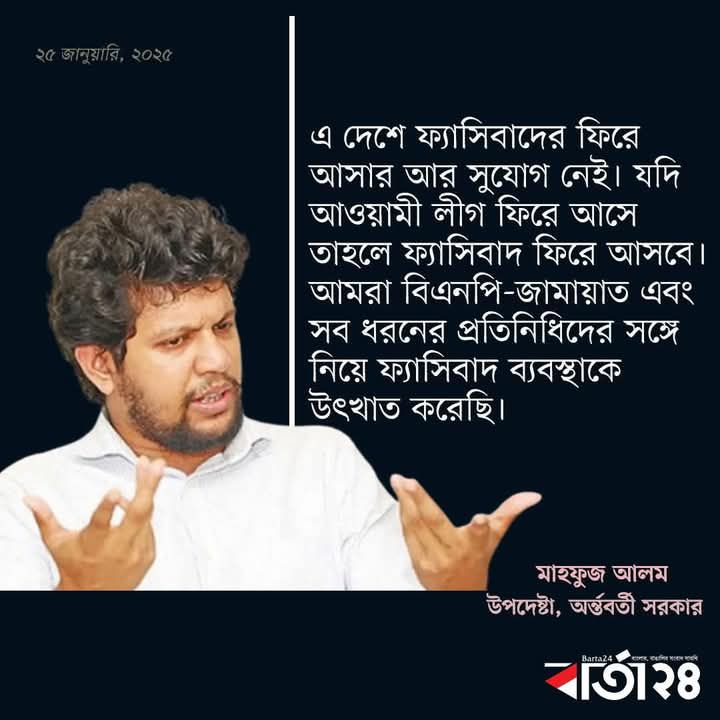As days are passing by, radical Islamists and extremist elements have gained more strength in Bangladesh since the August 5 changeover through mob violence, rumours–thanks to the US-sponsored and army-backed interim government’s patronization and silence of the legacy media.
In the last six months, several jihadist coordinators of the student movement, and leaders of Jamaat-e-Islami and its student front Islami Chhatra Shibir, and al-Qaeda and Taliban affiliates have celebrated publicly their role in the overthrowing of secularist Awami League government.

Latest, in a video interview, former Chhatra Shibir president Mirza Galib said they prepared the nine-point charter–adding demands that would be hard for the government to agree to–when they had learnt that the Awami League would agree to the students’ demand for abolishing the quota system again.
Earlier, former president of the Dhaka University unit Chhatra Shibir, Md Abu Shadik Kayem, revealed in an op-ed published by pro-Jamaat Amar Desh newspaper how his radical Islamist party coordinated the movement and deployed cadres at 10 points of the capital city to force the government resign from August 3–two days after the government banned Jamaat-Shibir blaming it for widespread arson attacks and murder of police and ruling party members.
Kayem never used his political identity during the movement while the mainstream media also didn’t mention it though it’s a fundamental principle of journalism. After the OHCHR released its full report last week, he said in a Facebook post that his team was closely working with the fact-finding mission on the ground.
Moreover, the Dhaka University unit’s former general secretary, Farhad Hossain, who was promoted to its president, revealed his identity after the successful completion of the mission.
On the other hand, the media wing chief of banned extremist group Hizb ut-Tahrir, told the BBC Bangla that they had kept their identities secret during the movement. After Sheikh Hasina’s fall, jihadists carried out victory processions in Dhaka and some other districts with the ISIS flags and demanded that the interim government withdraw the ban.






Throughout the history of militant activities in Bangladesh since 2000, it was found that most of these groups were led by people linked to Jamaat and Hizb ut-Tahrir and had direct links to Pakistan-based extremist groups Harkatul Jihad al Islami (HUJI) and Al-Qaeda in the Indian Subcontinent (AQIS) and Taliban.
These claims are corroborated by several coordinators of the movement; for example, Sarjis Alam and Hasnat Abdullah. Their senior leader, Mahfuj Alam, who is now an adviser, revealed that they had allowed students from all quarters, including pro-liberation activists and secularists, to act freely (lighting candles and singing songs of the 1971 war). Hasnat told a talkshow that they had chanted slogans of the 1971 war as a tactic to draw the support of general students.
Meanwhile, al-Qaeda spiritual leader Jasimuddin Rahmani and Taliban supporters Mufti Harun Izhar and Mamunul Haque have said on many occasions since the August 5 changeover that their networks were very active during the movement, and they all demanded unanimously that the interim government must abolish secularism and eliminate the Awami League.
Another most-wanted extremist, sacked army official Syed Ziaul Haque, entered Bangladesh with Pakistani passport in December–around 12 years after he went into hiding. Before that, he gave an interview with Al Jazeera reporter Zulkarnain Saer Sami, demanding that the army reinstated him and conferred gallantry award Bir Uttam. Zia, who is wanted by the US and Bangladesh authorities for militant activities, also wanted the $5 million bounty be withdrawn by the US State Department.
The interim government’s reform commissions have made their proposals following the demands of the jihadists. It also remained silent when the extremists dismantled all sculptures and symbols of the 1971 war, the Father of the Nation Bangabandhu Sheikh Mujibur Rahman, and attacked the pro-Awami League minorities, sufi shrines and cultural events.
The government has also met their demands for renaming every institution and establishment, carrying the names linked to the Awami League and is poised to ban the Awami League before holding the national elections.
It’s also not surprising that the government is patronizing jihadists and Jamaat-e-Islami to carry out political campaigns under police protection, and in the formation of the King’s party with radical political elements linked to Jamaat, ultra left parties and anti-Awami League cultural activists and civil society members. The above-mentioned facts also justify the interim government’s anti-India stance and love for Pakistan.
The Islamization is also seen vivid in the field administration, judiciary and the police, with government officials sheltering the jihadists and releasing them from jail, and taking action against the media and rights activists for criticizing the government for nepotism, extortion and violation of the Constitution. On the other hand, arbitrary arrests, filing of fictitious cases and denial of bail prayers are some examples of the government’s inclination to extremism.
Only a handful of senior journalists, who are brave enough to speak up, say they’ve never seen such anarchy in the country as well as in the media since 1971. The so-called civil society-led interim administration has cancelled press accreditation cards of hundreds of journalists, jailed dozens in murder cases so that they can’t get bail, and allowed the radical student leaders to occupy the newspaper and TV stations.


মন্তব্য করুন
মন্তব্য করার জন্য আপনাকে অবশ্যই লগইন করতে হবে।